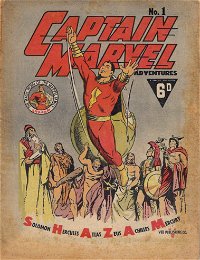Larry Cleland by James Zee
Introducing Larry Cleland
In 1946, during the post-war boom in Australian comics, the Vee Publishing Co.11The source of the name is unknown, but it is likely that, just a year after the end of World... entered the market with an extensive programme of US Fawcett reprints. This company became Larry Cleland Pty. Ltd around 1949/50, although Stanley Larry Cleland had been associated with the company since its foundation.
Cleland has no publishing record prior to Vee Publishing, and it is unknown how he secured the rights to Fawcett's material. However, the company quickly expanded its range of black and white reprint editions to include a dozen or more humour, super hero and western comics.
While the first few issues included a "Vee Publishing" logo,22See for example Captain Marvel Adventures 1.... the Fawcett name and branding dominated, with styling and trade dress similar to the US originals. Early editions even report Fawcett's senior editorial staff (Executive Editor Will Lieberson, Editor V.A. Provisiero) on the inner front cover.
The titles began with a few reprints from earlier years, but focused on Fawcett's contemporary material. The Australian comics are not exact replicas of the US editions, with often random reordering of stories. However, the majority of Fawcett's comic output between 1946 and 1953 (possibly excluding horror and romance) appears to have been made available to Australia.
The earliest titles from 1946 included Whiz Comics, Fawcett's Funny Animals and Captain Marvel Adventures. The Captain Marvel family became quickly popular, with the later Hopalong Cassidy (c 1947/48) cementing the company's early success.
Contemporary employment advertisements report the company "publishes high-class fast-selling American magazines"33The Argus (Melbourne), 30 October 1946. "CIRCULATION MANAGER: APPLICATIONS are invited for the position of Melbourne Circulation Manager for the... and is a "progressive publishing company affiliated with U.S.A. publishing corporation".44The Argus (Melbourne) Saturday 11 November 1950....
Cleland sems to have focused solely on reprints, without any of the significant Australian works that were commissioned by other publishers in the 1940s. However, it is possible some unidentified covers may have been drawn locally, and it is possible some Australian back up stories exist.
With a publishing programme uniquely dependent on Fawcett, Cleland faltered when its partner exited the comics field in 1953. Cleland never regained the success of its early years, but the upheaval led to an intereresting period of experimentation.



